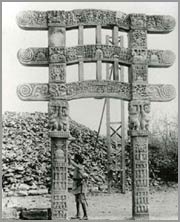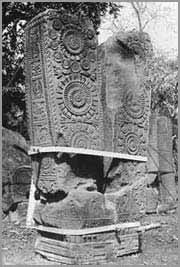Evidence Witness

In the establishment, through archaeological conservation, of what the British by the beginnings of the twentieth-century prudently referred to as the ‘national heirlooms’ of India, photographs bespoke of their efforts (Figure 20) and examples occur well before Marshall directed the conservation programme of the Archaeological Survey of India from 1903 onwards. At Sanchi, a photographic documentation of the gateways, or the Toranas, of the Mahastupa was undertaken between January and March 1900.
One objective was to furnish their records, of which the eastern one had already been replicated in plaster cast, with all details (Figure 21). The primary aim of the photo-documentation was to build up the entire elevation of all the standing gateways through the photographs. Henry Cousens, then superintendent archaeologist for Western India, who supervised this work, also devised a way of raising the camera through scaffolding, and moving it to various heights.

Cousens succeeded in taking more than 150 negatives, at the scale of 1/8th of the original. His Herculean efforts were detailed by Burgess within the pages of a journal where Indian history was then, literally, being made (Burgess 1902). The published photograph, Figure 22, was the ‘eye-witness’ for the reality of the undertaking.

